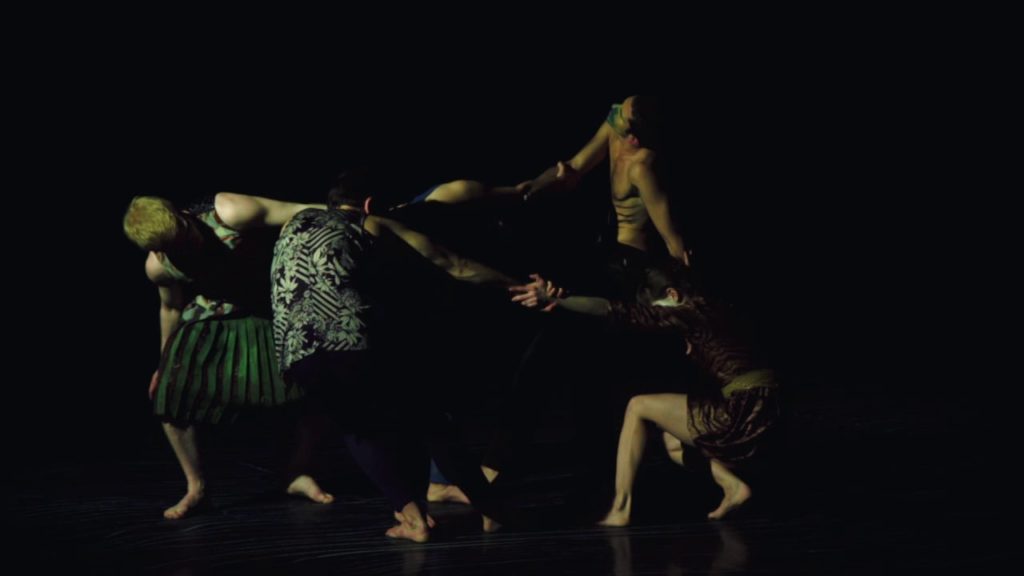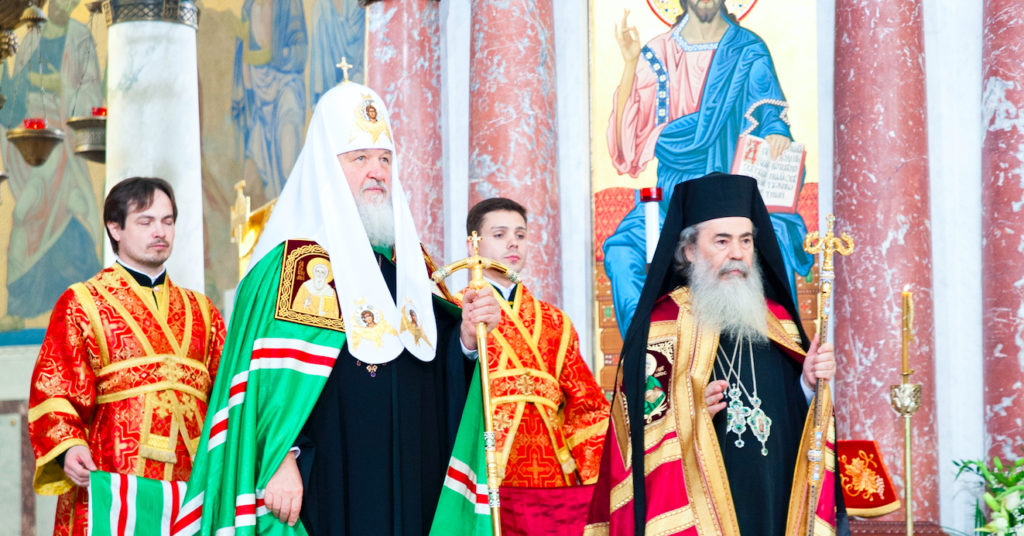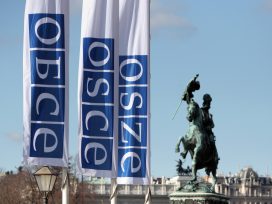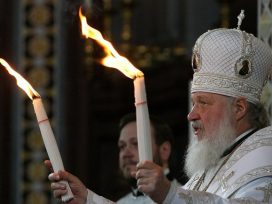An informal concordat: Culture wars in modern Russia
The constitutional separation between church and state in Russia is being ignored, writes Boris Falikov. He asks why the Kremlin’s partnership with the Orthodox church exists, and just how far it extends.
In the spring of 2015 the Metropolitan of Novosibirsk Tikhon brought a claim against the manager of the Novosibirsk Opera House, Boris Mezdrich, and the director Timofei Kuliabin. The latter had staged a production of Wagner’s Tannhauser and the Metropolitan insisted that the performance offended the religious feelings of believers. After the Pussy Riot affair (2012), changes were introduced in the Russian penal code and offending religious feelings is now considered a criminal offence. Together with my colleague from Moscow University, Vladimir Vinokurov, I was invited to be an expert witness at the court hearing. We both specialise in religious studies and the defence team wanted us to explain the religious symbolism of the performance.

A still from the trailer for Albert Quesada’s Wagner & Ligeti. Source: Vimeo
The young, innovative director modernized the libretto (a common practice in opera performances nowadays) and made Wagner’s minnesinger Tannhauser into an internationally famed film director. The protagonist shoots a movie about the ‘hidden years’ of Christ, who spends them in Venus’s grotto but then breaks out of his seductive captivity to go and complete his self-sacrificial deed. The film makes a scandal at an international festival; Tannhauser feels cursed and does a pilgrimage to Rome where the Pope himself pardons him. But at this point, the real-life Metropolitan of Novosibirsk, unlike the fictional head of the Catholic Church, decided to take a less merciful approach, and accused the director of the opera of depicting Christ on the Novosibirsk stage in an improper way. Arguments that the character in question was not the Christ of the Gospels but a Christ figure imagined by Kuliabin in a very different context failed to convince the metropolitan. He was supported in his claim by a small group of ‘true believers’ who didn’t see the performance but heard about its ‘attacks’ on the Orthodox Church. Needless to say, Metropolitan Tikhon also hadn’t seen the performance.
All these accusations based on hearsay didn’t surprise me very much. It was not the first, nor will it be the last case of culture war in today’s Russia. These cases follow a more or less similar pattern. Conservative believers want to monopolize religious symbolism and insist its use by modern artists is nothing but profanity. However the question with which the government prosecutor addressed me when I occupied the witness stand did surprise me. He asked me if I believed in God. The defence lawyer objected that I shouldn’t be asked personal questions of this kind. But it didn’t stop the prosecutor, who promised me all the fires of hell if I dared to defend such a sacrilegious opera performance.
Culture wars are fought all over the world today but, as I surmised from my experience in the Novosibirsk court, the position of the Russian government might be closer to that of the countries of the Global South than those of the West. It was not the position of a neutral arbiter, as it is supposed to be in countries where the church is separated from state. But according to the article 14 of the Russian Constitution it is! Here I will try to explain this contradiction.
Orthodox believers as a power base
The new Russian constitution was adopted in 1993. After more than 70 years of ‘scientific atheism’, which was part and parcel of the official Communist ideology, it declared both the independence of the church from the state, and freedom of belief. The revival of religious beliefs started immediately. The Russian Orthodox Church (ROC) was the leader of this revival and public opinion surveys showed that the number of Orthodox believers was snowballing. In the middle of the 1990s it was 30‑35% of the population, and a decade later it had practically doubled. The rulers of the new Russia understood perfectly well that Orthodox believers formed a strong power base and tried their best to make friends with the ROC. First, Russian president Boris Yeltsin made amendments to the Constitution in 1997, which declared the Orthodox faith (together with Islam, Buddhism and Judaism) to be ‘traditional religions’ of Russia. Whatever else this might possibly mean, it favoured the ROC over Catholics and Protestants and the Orthodox church immediately started to take an advantage of it. The ROC began lobbying teaching ‘Orthodox culture’ in schools and introducing chaplains into the Russian army and penitentiary institutions. At first this didn’t meet with much opposition, as trust in the ROC was relatively high. According to surveys it was trusted by 40‑50% of the population. But some parents were still concerned that ‘Orthodox culture’ might be imposed on their children in schools, and expressed their disagreement. Much more criticism followed after the ROC tried to appropriate some museums located within monasteries and nunneries. The museum experts objected that their new owners didn’t have experience of restoring ancient buildings and art objects. The treatment of old frescos and icons prompted particular concern, and some of them were certainly irreversibly damaged.
The situation started to change drastically when Patriarch Alexey II died in 2008 and a new patriarch, Kirill, was enthroned the following year. He was a young (b. 1946) and very energetic administrator. The church’s lobbying efforts doubled under his skilful guidance and very soon the ROC became the only institution in the country to secure restitution rights. This meant that all its pre-revolutionary property had to be returned to it. Needless to say, its conflicts not only with museums but many other current owners of property reached a new level of intensity.

Patriarch Kirill, head of the Russian Orthodox Church. Author: Saint-Petersburg Theological Academy. Source: Flickr
Under the new patriarch, the ROC started to expand forcefully into the social and cultural life of the country. It took conservative stands on public morality (against abortion and LGBT rights), contemporary art (accusing artists of offending religious feelings), science (coming out against the theory of evolution theory and genetic engineering) and family issues (opposing children rights and artificial fertilization), etc. This ROC activity affected the practical interests of many social groups. First of all, it could not but cause a negative reaction among the educated, urban population. Modern artists complained that their creative freedom was being violated. The ‘true believers’ as they liked to call themselves, raided contemporary art exhibitions, accusing the artists of profanity and blasphemy, and invading the stage in order to disrupt performances they declared sacrilegious. The scientists complained that obscurantists were interfering with their research. A real scandal ensued when a chair of theology was established at the National Nuclear Research University in Moscow.
Much wider strata of society were also affected by the church’s conservative activism. Women became frightened that they would be deprived of their freedom of choice. Indeed, the patriarch signed a collective letter demanding that abortions be outlawed. Moreover, the ROC started lobbying for new laws aimed at taking abortion costs out of the state health insurance package. Rights to artificial fertilization were also threatened.
The culture wars became inevitable in Russia.
The ideology of ‘traditional values’
Obviously, all these successful social and cultural initiatives by the ROC would not have been possible without the strong support of the state. It’s understandable that the Russian authorities continue to cultivate its power base of Orthodox believers. But why should they do so in the face of growing public opposition, at least to some of the church’s initiatives? The answer to this question lies in the change of policy that Putin’s regime had been taking both at home and abroad. It represented a sharp turn to the right, and this political manoeuvre needed a new ideology of its own. The natural conservatism of the ROC became part and parcel of this ideology of returning to ‘traditional values’ rooted in the glorious past of great Russia.
That’s how an informal concordat was formed between state and church in Russia. I call it ‘informal’, because the separation clause remained intact in the constitution. However, in reality the authorities did everything possible to support ROC initiatives and Orthodoxy started to function as an important source of the new state ideology. Certainly, some of the Orthodox mythologemes were secularized during this process. For example, the idea of the ‘Russian world’ first formulated by Patriarch Kirill was based on the historical fact that Kievan prince Vladimir baptized the ancient Slavs in 988. The patriarch used this to show the original unity of three Slavic nations based on their common faith and to prove the right of the Moscow Patriarchate to function in Russia, Belarus and Ukraine. But the Kremlin used this to justify the annexation of Crimea in 2014. Another example of secularized usage of Orthodox teaching by the government was its anti-abortion stand. For the church, it was a moral issue but for the authorities it was a way to solve the demographic crisis. However the ROC didn’t mind the secularization of its teaching by the government as long as it helped to strengthen its beneficial ties with the state. Besides, the ROC could always rely on the authorities if it felt threatened. Indeed, after the ‘punk prayer’ performed by the band Pussy Riot in the Cathedral of Christ the Saviour in Moscow, article 148 was amended so that offending religious feelings became a criminal offence.
Meanwhile a strong secularist faction started to form in Russian society as a response to this ideological alliance. Mostly, its members belonged to the educated urban population, but lately a hostile attitude towards the ROC has started to spread among wider strata of Russian society. While the initial group opposed the obvious breach of the constitution, leading to what they termed ‘the clericalisation of society’, a second group was outraged by the reportedly huge financial rewards that the ROC received from the government. In their eyes, this was pure corruption. The stories of the very costly watches Patriarch Kirill was observed wearing, and of young priests driving luxury cars, became very popular on the Russian internet.
This anger at the ROC’s increasing conservative interference in the social and cultural life of society, assisted by the Russian government, strengthens ‘the anticlerical front’. But its enemies in the culture wars are more numerous. They wholeheartedly support the ‘traditional values; declared by the Kremlin and the church. As a result xenophobia, nationalism and homophobia fuelled by new ideology are growing. This makes the culture wars more and more ferocious. What can we expect to happen next?
The future of the culture wars
The Putin regime is not as sure of itself as it seems from outside. The huge ‘patriotic’ majority which formed as its support base after the annexation of Crimea seems to be eroding lately because of worsening economic conditions. In 2018 Putin will face a new election (he has not yet declared his intention officially, but practically nobody doubts it). In this situation two scenarios are possible. The first one is a new mobilization of Putin’s majority. It would mean increasing pressure on the ‘non-agreeing’ minority, making it, together with its Western patrons, a scapegoat for Russia’s problems. This will result in a further strengthening of ‘traditional values’ ideology and government support for the ‘true believers’ faction in the culture wars. The second scenario is the complete opposite. The Kremlin might try not to rock the boat and polarize society. In this case it will distance itself from the culture wars, letting them run their natural course.
There are at least two examples of this policy lately. The governor of St. Petersburg, Georgy Poltavchenko, a former KGB officer and an ardent Orthodox believer (he makes often pilgrimages to the sacred Mt. Athos in Greece) declared in the beginning of 2017 that he would give over the famous St. Isaac’s Cathedral to the ROC (presently it is a museum). The outraged public, headed by the secularist faction, started fiercely protesting against the decision. A whole movement was formed and the ‘St. Isaac’s affair’ got onto the national news. After a few weeks of growing debate the Kremlin declared that it didn’t have a hand in the decision and that it was an initiative of Governor Poltavchenko. What will happen in the end is not clear but the signal from the Kremlin definitely meant it preferred a neutral position.
The second example of the Kremlin’s relative moderation was the case of Ruslan Sokolovsky in Yekaterinburg. The young blogger played Pokémon Go in one of the city’s churches and made a video of it in his blog, with some anticlerical comments. The local church authorities sued the blogger for offending religious feelings. Sokolovsky was arrested and a prosecutor demanded a sentence of 3.5 years. But a big public uproar followed, and even the governor of Yekaterinburg, Yevgeny Roizman, said the verdict might be too severe. Finally, the court decided on a suspended sentence. As the court system in Russia is far from independent, the public took this as a sign that the Kremlin doesn’t want to rock the boat before the presidential election.
Whichever of these two scenarios the Kremlin finally prefers, neither means that the policy of ‘traditional values’ and informal concordat with the ORC will fundamentally change. Putin’s regime has tied its political destiny too tightly to it. A change of course might happen only after its demise. Until then, the Russian state will remain an engaged party in the culture wars.
Published 27 July 2017
Original in English
First published by Eurozine
Contributed by IWM © Boris Falikov / IWM / Eurozine
PDF/PRINTIn collaboration with
In focal points
Newsletter
Subscribe to know what’s worth thinking about.
Related Articles

For those who suffered the consequences of Yalta’s division of Europe, the Helsinki Final Act brought grounds for optimism. Today, as Russia’s regressive war on Ukraine reopens old conflicts, it stands as a monument to European modernity.

From Helsinki to full-scale invasion
Russia, European security and the OSCE
Russia’s invasion of Ukraine, and its denial of rights at home, are precisely the kind of development that the Organization for Security and Co-operation in Europe was set up to prevent. So why has the OSCE failed to fulfil its purpose?






